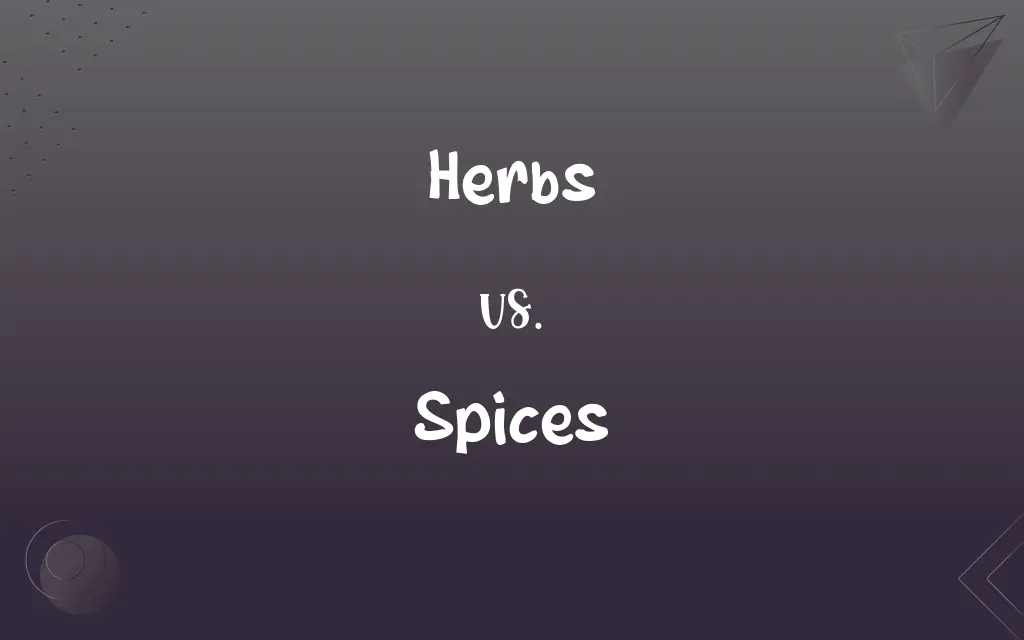Herbs vs. Spices: What's the Difference?
Edited by Janet White || By Harlon Moss || Updated on October 22, 2023
Herbs are leaves or stems of plants used for flavoring, while spices come from roots, bark, or seeds.

Key Differences
Herbs are generally derived from the leaves or stems of plants. They are often green and can be used both dried and fresh. Spices, on the other hand, are primarily obtained from the roots, bark, seeds, or fruit of plants. They often exhibit a diverse range of colors and are usually used in their dried form.
In the culinary world, herbs provide subtle flavors and are often added at the end of the cooking process to retain their delicate aromas. Spices, contrastingly, impart a more robust and intense flavor and are usually added at the beginning or during cooking.
Herbs like basil, rosemary, and mint are popular in various cuisines for their refreshing and aromatic properties. Spices like cinnamon, cumin, and turmeric are known for their strong, pungent, and sometimes spicy notes, which can define a dish's character.
Many cultures have utilized herbs for their medicinal properties for centuries. Spices, too, have been historically prized, not just for flavoring, but for their medicinal and preservative qualities. Both herbs and spices have played significant roles in trade, medicine, and culinary arts throughout history.
Comparison Chart
Part of Plant Used
Leaves or stems
Roots, bark, seeds, or fruit
ADVERTISEMENT
Flavor Intensity
Subtle
Robust
Common Usage
Often fresh but can be dried
Typically dried
Examples
Basil, rosemary, mint
Cinnamon, cumin, turmeric
Historical Usage
Both culinary and medicinal
Culinary, medicinal, and preservative
Herbs and Spices Definitions
Herbs
Herbs can have medicinal properties.
Many people drink herbal teas for their soothing effects.
ADVERTISEMENT
Spices
Spices are typically dried before use.
She stored her spices in airtight containers.
Herbs
Herbs are often used fresh in dishes.
She garnished the dish with fresh parsley.
Spices
Spices are derived from roots, bark, seeds, or fruits of plants.
He added a pinch of the spice to the curry.
Herbs
Herbs can be either annual or perennial plants.
Basil and cilantro are examples of annual herbs.
Spices
Spices can have a strong, pungent flavor.
The spices gave the dish a kick.
Herbs
Herbs are the leaves or stems of plants used in cooking.
She added fresh herbs to the salad.
Spices
Spices have played a pivotal role in global trade.
Centuries ago, spices like black pepper were worth their weight in gold.
Herbs
Herbs can provide aromatic qualities to dishes.
The aroma of the herbs wafted through the kitchen.
Spices
Spices can possess preservative qualities.
Spices were historically used to preserve meat.
Herbs
A plant whose stem does not produce woody, persistent tissue and generally dies back at the end of each growing season.
Spices
Any of various pungent, aromatic plant substances, such as cinnamon or nutmeg, used to flavor foods or beverages.
FAQs
Are spices generally stronger in flavor than herbs?
Yes, spices usually have a more robust and intense flavor compared to herbs.
Can herbs be used for medicinal purposes?
Yes, many herbs have medicinal properties and have been used in traditional medicine for centuries.
Can both herbs and spices offer health benefits?
Yes, many herbs and spices are rich in antioxidants and offer various health benefits.
Is it better to store herbs and spices away from direct sunlight?
Yes, to retain their flavor and potency, it's best to store both herbs and spices away from direct sunlight and heat.
What's a popular herb used in Italian cooking?
Basil is a popular herb used in Italian dishes.
Can spices enhance the color of a dish?
Yes, spices like turmeric and paprika can add vibrant colors to dishes.
Are herbs usually green?
Yes, herbs are often green, especially when fresh.
What is an example of a spice derived from bark?
Cinnamon is a spice derived from the bark of trees.
Are spices typically used in their fresh form?
No, spices are typically dried before use.
Which is more aromatic, herbs or spices?
Both can be aromatic, but herbs are often prized for their refreshing and aromatic qualities.
Can spices be used as a preservative?
Yes, some spices have preservative qualities and were historically used to preserve food.
Is basil an herb or a spice?
Basil is an herb.
Can herbs be used both fresh and dried in cooking?
Yes, herbs can be used both fresh and dried, depending on the recipe.
Do herbs generally have a shorter shelf life than spices?
Yes, especially when fresh, herbs tend to have a shorter shelf life compared to dried spices.
Are herbs generally milder than spices?
Yes, herbs generally provide a more subtle flavor compared to the robust nature of spices.
What part of a plant do herbs typically come from?
Herbs typically come from the leaves or stems of plants.
What parts of plants are spices derived from?
Spices are derived from roots, bark, seeds, or fruits.
Is turmeric an herb or a spice?
Turmeric is a spice.
Were spices historically significant in trade?
Yes, spices played a crucial role in global trade, with some even being used as currency.
Which is typically more expensive, herbs or spices?
It depends on the specific herb or spice, but some spices, due to their harvesting process or rarity, can be more expensive.
About Author
Written by
Harlon MossHarlon is a seasoned quality moderator and accomplished content writer for Difference Wiki. An alumnus of the prestigious University of California, he earned his degree in Computer Science. Leveraging his academic background, Harlon brings a meticulous and informed perspective to his work, ensuring content accuracy and excellence.
Edited by
Janet WhiteJanet White has been an esteemed writer and blogger for Difference Wiki. Holding a Master's degree in Science and Medical Journalism from the prestigious Boston University, she has consistently demonstrated her expertise and passion for her field. When she's not immersed in her work, Janet relishes her time exercising, delving into a good book, and cherishing moments with friends and family.
































































